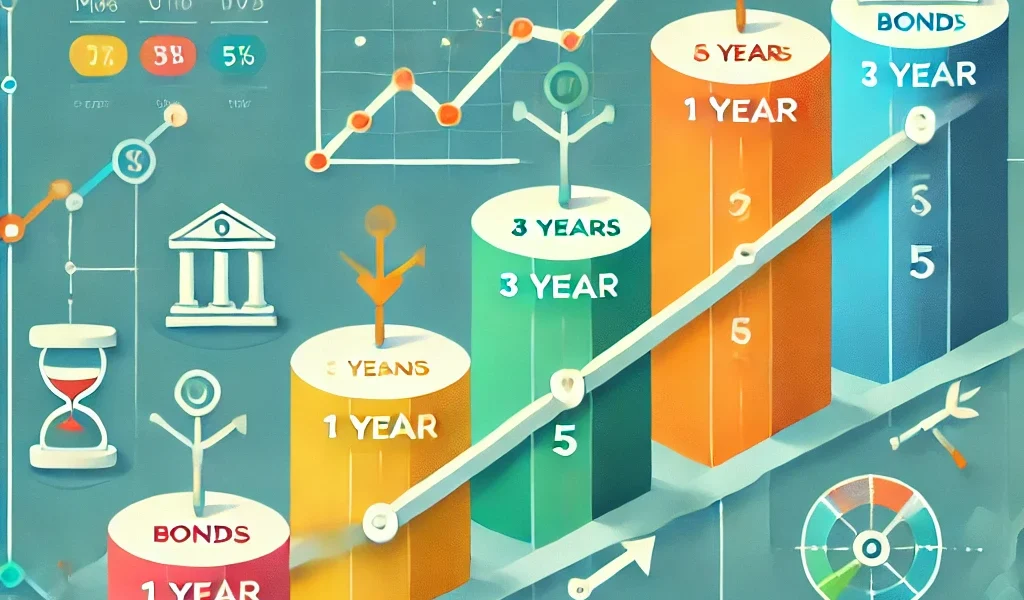Investors seeking predictable and steady income often turn to bond ladders as a strategic solution. A bond ladder is a portfolio of bonds with staggered maturity dates that ensures continuous income and reduces reinvestment risk. This approach can be particularly advantageous for retirees or conservative investors looking for low-risk, steady returns.
In this comprehensive guide, we will explore the concept of bond ladders, highlight their advantages and risks, and provide a step-by-step approach to building a diversified bond ladder to generate consistent income.
📚 What Is a Bond Ladder?
A bond ladder is an investment strategy that involves purchasing multiple bonds with staggered maturity dates. Instead of investing in a single bond with a fixed maturity, you create a series of bonds that mature at different intervals, providing regular access to cash and minimizing reinvestment risks.
🔍 How It Works:
- Multiple Bonds with Varying Maturities: A bond ladder typically consists of bonds with staggered maturities (e.g., 1-year, 3-year, 5-year, 7-year, and 10-year).
- Reinvestment of Maturing Bonds: As each bond matures, the proceeds are reinvested in a new bond at the longest maturity of the ladder, extending the income stream.
- Continuous Cash Flow: This approach creates a steady income stream over time while allowing the investor to take advantage of changing interest rates.
🎯 Why Consider a Bond Ladder?
✅ 1. Consistent Cash Flow
A bond ladder ensures that you receive regular interest payments and periodic principal repayments, creating a predictable income stream.
✅ 2. Diversification Across Maturities
By spreading your investments across bonds with varying maturities, you reduce interest rate risk and mitigate the impact of market volatility.
✅ 3. Mitigates Reinvestment Risk
Reinvestment risk occurs when bonds mature and interest rates are lower than before. A bond ladder minimizes this risk by staggering maturity dates.
✅ 4. Flexibility and Liquidity
As bonds mature, you can choose to reinvest the proceeds, withdraw the cash, or adjust the ladder to meet your evolving financial needs.
🛠️ Step-by-Step Guide to Building a Bond Ladder
📈 Step 1: Define Your Investment Goals
Before building a bond ladder, clarify your financial objectives, such as:
- Generating Steady Income: Ideal for retirees or income-focused investors.
- Preserving Capital: Suitable for conservative investors seeking to minimize risk.
- Managing Interest Rate Risk: Reduces sensitivity to interest rate fluctuations.
📊 Step 2: Determine Your Investment Horizon
Decide how long you want your bond ladder to last. Bond ladders typically range from 5 to 10 years, depending on your goals. A longer ladder provides greater protection from reinvestment risk but may reduce liquidity.
💸 Step 3: Set Your Budget and Diversify Investments
Allocate your investment budget across bonds of varying maturities. For example:
- Invest 20% in 1-year bonds.
- Invest 20% in 3-year bonds.
- Invest 20% in 5-year bonds.
- Invest 20% in 7-year bonds.
- Invest 20% in 10-year bonds.
This allocation ensures that bonds mature at regular intervals, giving you flexibility when reinvesting proceeds.
🏦 Step 4: Choose the Right Bonds
Select bonds that align with your investment goals and risk tolerance. Consider the following options:
- Government Bonds: U.S. Treasury bonds or municipal bonds for safety and tax advantages.
- Corporate Bonds: Investment-grade bonds offering higher yields but with slightly higher risk.
- Municipal Bonds: Tax-exempt bonds ideal for high-income investors.
📆 Step 5: Ladder Your Bond Portfolio
Buy bonds with staggered maturities. For instance, if you are building a 5-year bond ladder, your portfolio may include:
- 1-year bond: Matures in Year 1.
- 2-year bond: Matures in Year 2.
- 3-year bond: Matures in Year 3.
- 4-year bond: Matures in Year 4.
- 5-year bond: Matures in Year 5.
🔄 Step 6: Reinvest Maturing Bonds
When each bond matures, reinvest the proceeds into a new bond with the longest maturity of the ladder. This process extends the ladder and maintains a steady income stream.
📊 Step 7: Monitor and Rebalance Regularly
Periodically review your bond ladder to ensure it aligns with your goals and market conditions. Rebalance as needed by adjusting maturities or reallocating funds.
📉 Risks Associated with Bond Ladders
⚠️ 1. Interest Rate Risk
While a bond ladder mitigates interest rate risk, rising interest rates may still reduce the market value of your bonds. However, reinvesting proceeds at higher rates over time can offset these losses.
📉 2. Credit Risk
Corporate bonds, especially those with lower credit ratings, may carry a higher risk of default. Stick to investment-grade bonds for safer returns.
💸 3. Inflation Risk
Since bond payments are fixed, inflation can erode the purchasing power of future cash flows. To hedge against inflation, consider incorporating Treasury Inflation-Protected Securities (TIPS) in your bond ladder.
📈 How to Optimize Your Bond Ladder for Maximum Returns
📊 1. Include a Mix of Bonds
Diversify across government, corporate, and municipal bonds to balance safety and yield.
🔄 2. Reinvest Strategically
When reinvesting proceeds from maturing bonds, choose bonds with favorable interest rates to maintain the stability and growth of your ladder.
🎯 3. Monitor Interest Rate Trends
Stay informed about market conditions and adjust your bond ladder if interest rate trends change significantly.
📊 Example of a 5-Year Bond Ladder
| Year | Bond Maturity | Investment Amount | Interest Rate |
|---|---|---|---|
| Year 1 | 1-Year Bond | $10,000 | 2.5% |
| Year 2 | 2-Year Bond | $10,000 | 3.0% |
| Year 3 | 3-Year Bond | $10,000 | 3.5% |
| Year 4 | 4-Year Bond | $10,000 | 4.0% |
| Year 5 | 5-Year Bond | $10,000 | 4.5% |
As each bond matures, reinvest the proceeds into a new 5-year bond to extend the ladder.
💡 Advantages of a Bond Ladder
✅ 1. Predictable Income
Bond ladders offer regular interest payments and maturing principal, ensuring a steady income stream.
✅ 2. Flexibility in Changing Markets
By staggering maturity dates, bond ladders allow you to reinvest proceeds at prevailing interest rates, reducing the impact of interest rate fluctuations.
✅ 3. Reduced Reinvestment Risk
Since not all bonds mature at once, you avoid the risk of reinvesting large sums in a low-interest rate environment.
❗️ Disadvantages of a Bond Ladder
⚠️ 1. Lower Potential Returns
Bond ladders prioritize safety and stability over high returns. Investors seeking aggressive growth may find other strategies more appealing.
⚠️ 2. Time and Effort
Building and managing a bond ladder requires periodic monitoring and reinvestment, which may be cumbersome for passive investors.
🎨 Final Thoughts: Is a Bond Ladder Right for You?
A bond ladder can be a powerful strategy for generating steady income while mitigating interest rate and reinvestment risks. It is ideal for:
- Retirees seeking reliable income.
- Conservative investors looking for predictable returns.
- Investors who want to balance safety and flexibility in changing market conditions.
By diversifying across maturities and regularly reinvesting proceeds, a well-constructed bond ladder can offer long-term financial stability and consistent income.




